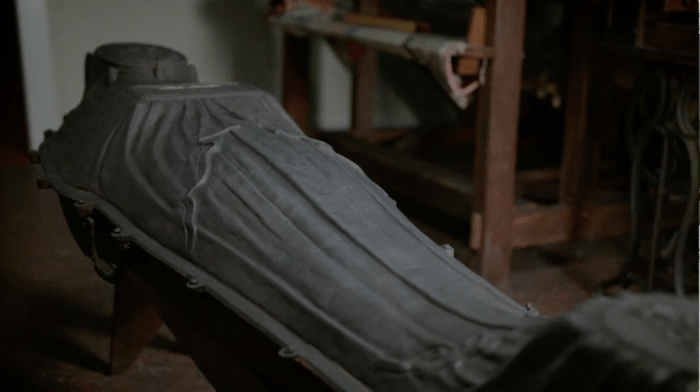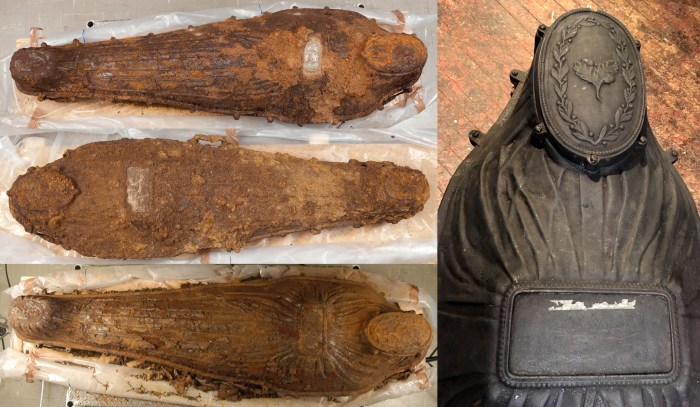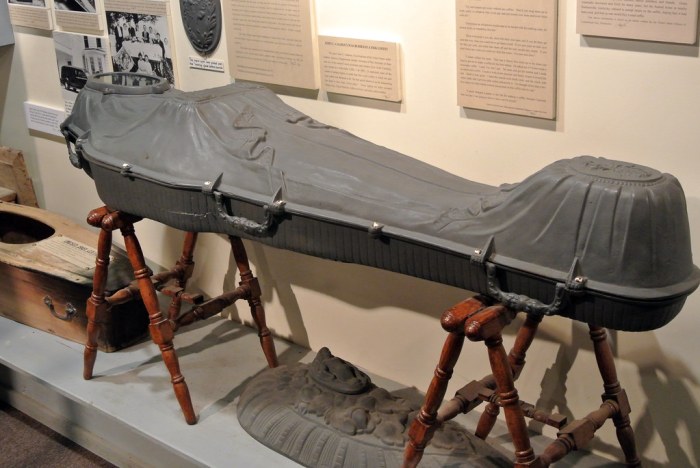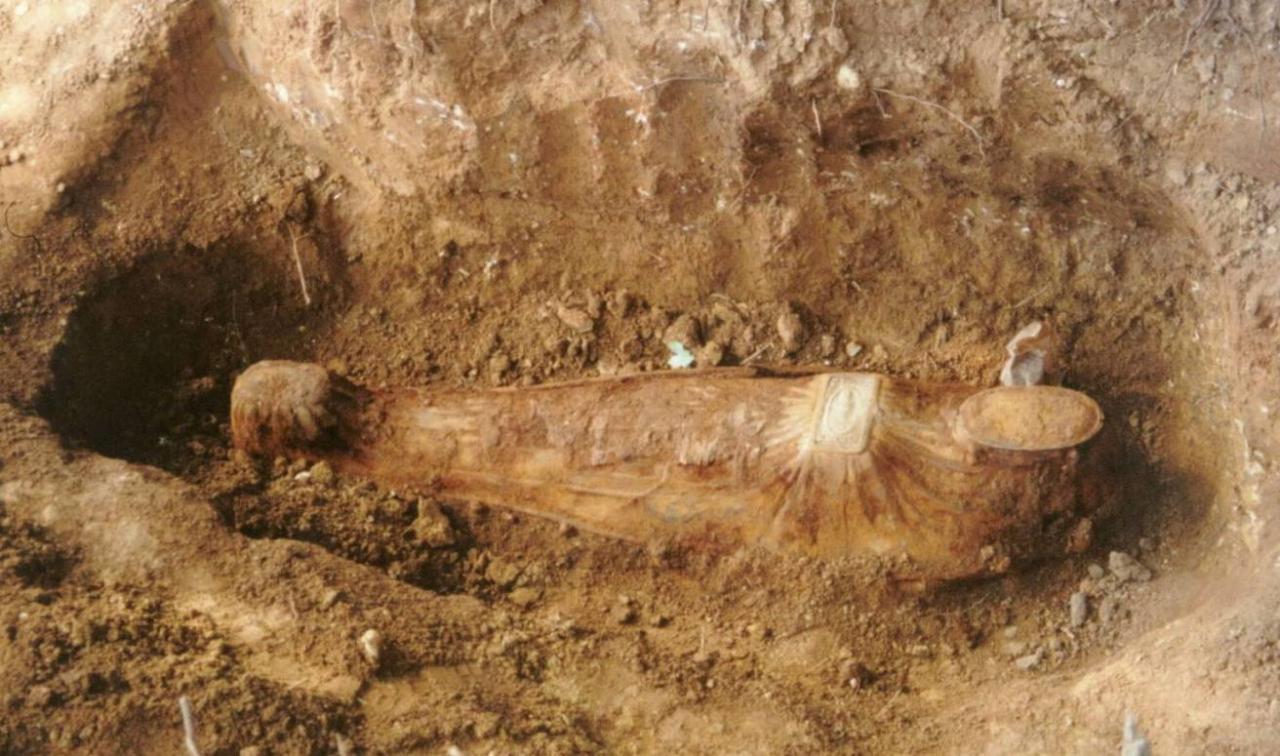Fisk iron coffin for sale – Introducing Fisk iron coffins for sale, a unique opportunity to own a piece of history. These meticulously crafted coffins, steeped in Victorian-era significance, offer a glimpse into the past and the intricate artistry of the time.
Fisk iron coffins, with their distinctive designs and enduring construction, stand as testaments to the ingenuity and craftsmanship of their makers. Their historical significance and cultural impact make them not just a collector’s item but a captivating conversation piece.
Fisk Iron Coffin Historical Significance
The Fisk iron coffin, a pioneering innovation in the funeral industry, emerged in the mid-19th century as a response to the rampant spread of contagious diseases and the growing concerns over public health.
Origins and History
The brainchild of Reverend George Fisk, a minister from Massachusetts, the iron coffin was initially conceived as a sanitary alternative to traditional wooden caskets. In the wake of devastating epidemics like cholera and yellow fever, Fisk recognized the need for a more effective means of preventing the spread of infection.
In 1848, Fisk patented his invention, which featured a sturdy iron construction with an airtight seal. The iron coffin’s durability and resistance to decomposition made it an ideal solution for transporting and interring the deceased, minimizing the risk of disease transmission.
Unique Design and Construction
Fisk iron coffins were meticulously crafted from cast iron, renowned for its strength and longevity. The coffins were typically rectangular in shape, with a hinged lid that could be securely locked to prevent accidental opening.
To ensure an airtight seal, the lid was fitted with a rubber gasket and sealed with a tar-based compound. This airtight construction effectively prevented the leakage of bodily fluids and the entry of external contaminants, contributing to the coffin’s sanitary properties.
Cultural and Societal Impact
The introduction of Fisk iron coffins had a profound impact on funeral practices and public health. The coffins’ ability to prevent the spread of disease made them widely adopted by hospitals, funeral homes, and families alike.
Fisk iron coffins also played a significant role in shaping cultural attitudes towards death and burial. Their durability and permanence challenged traditional notions of impermanence and decay, offering a sense of security and closure to grieving families.
Fisk Iron Coffin Design and Features

Fisk iron coffins were constructed using cast iron, a material known for its strength and durability. The manufacturing process involved melting iron ore in a furnace and pouring the molten metal into molds shaped like coffins. This technique allowed for intricate details and precise dimensions.
The use of iron as the primary material offered several advantages. Iron is highly resistant to corrosion and decay, ensuring the coffin’s longevity. Its strength provided protection against external forces, preventing damage to the casket’s contents. Additionally, iron’s thermal conductivity helped regulate temperature, preserving the body’s condition for longer periods.
However, there were also some disadvantages associated with using iron. The material’s weight made the coffins heavy and difficult to transport. Furthermore, iron is susceptible to rust if not properly coated or treated, which could compromise its durability over time.
If you’re looking for a unique way to preserve your loved one’s memory, consider a fisk iron coffin. These durable and elegant coffins are a beautiful and respectful way to honor the departed. They’re also surprisingly affordable, especially when you consider that julio is paid 1.4 times as much as other funeral providers.
So if you’re looking for a high-quality, affordable coffin, a fisk iron coffin is the perfect choice.
Intricate Details
Fisk iron coffins showcased intricate details that reflected the craftsmanship and artistry of their makers. The coffins were often adorned with elaborate carvings, including floral motifs, biblical scenes, and personal symbols. The interior of the coffins was also carefully designed, featuring padded lining and adjustable headrests for comfort and support.
Fisk Iron Coffin Production and Distribution
The production of Fisk iron coffins was a complex and labor-intensive process. The coffins were made of cast iron, which was poured into molds and then allowed to cool and solidify. The molds were made of sand, and each coffin required a unique mold.
The casting process was dangerous, and there were often accidents.
Factories and Locations
Fisk iron coffins were manufactured in a number of factories in the United States. The first factory was located in Saratoga Springs, New York, and was founded in 1848. Other factories were later established in Albany, New York; Boston, Massachusetts; and Philadelphia, Pennsylvania.
Distribution Channels and Target Markets
Fisk iron coffins were sold through a variety of distribution channels, including funeral homes, hardware stores, and general stores. The target market for these coffins was primarily wealthy families who could afford the high cost.
Fisk Iron Coffin Sales and Marketing

Fisk iron coffins were marketed through a variety of channels, including print advertising, trade shows, and direct mail. The target audience for these coffins was primarily funeral directors, who would then sell them to families. The coffins were marketed as being durable, airtight, and fireproof, which made them appealing to families who wanted to protect their loved ones’ remains.
Pricing and Availability
Fisk iron coffins were priced at around $100 during their time of production. They were available in a variety of sizes and styles, and could be customized to meet the needs of individual families. The coffins were sold through a network of funeral directors across the United States.
Fisk Iron Coffin Cultural and Societal Impact: Fisk Iron Coffin For Sale

Fisk iron coffins played a significant role in Victorian society, shaping funeral practices and mourning rituals while influencing perceptions of death and the afterlife.
Role in Funeral Practices, Fisk iron coffin for sale
- Durability and Preservation:Iron coffins offered superior protection against decay, ensuring the preservation of the deceased’s remains for extended periods.
- Transportation:The sturdy construction of iron coffins facilitated the transportation of bodies over long distances, making it possible for families to conduct funerals away from their hometowns.
- Sanitation:Iron coffins helped prevent the spread of disease by sealing the remains hermetically, reducing the risk of contamination.
Mourning Rituals
Fisk iron coffins influenced mourning practices by providing a tangible symbol of loss and grief:
- Elaborate Decoration:Coffins were often adorned with intricate carvings, engravings, and paintings, reflecting the deceased’s personality and social status.
- Viewing and Wake:Iron coffins allowed for extended viewing and wakes, giving family and friends ample time to pay their respects and mourn.
- Memento Mori:The presence of an iron coffin served as a constant reminder of the inevitability of death, encouraging contemplation and introspection.
Perception of Death and the Afterlife
Fisk iron coffins influenced Victorian attitudes towards death and the afterlife:
- Physicality of Death:The durable nature of iron coffins reinforced the belief in the physicality of death, emphasizing the preservation of the body.
- Immortality:The symbolism of iron as a material associated with strength and longevity suggested a desire for immortality and the preservation of the deceased’s memory.
- Christian Eschatology:The belief in resurrection and the eventual reunion of body and soul was reflected in the use of iron coffins, which promised to protect the remains until the day of judgment.
Fisk Iron Coffin Preservation and Restoration

Preserving and restoring Fisk iron coffins involves a delicate balance between maintaining their historical integrity and ensuring their longevity for future generations. Techniques include cleaning, stabilization, and conservation, guided by ethical principles to minimize alterations.
Challenges and Ethical Considerations
Restoring Fisk iron coffins presents challenges due to their age, deterioration, and potential historical significance. Restorers must carefully assess the condition of each coffin and determine the appropriate level of intervention. Ethical considerations include respecting the original craftsmanship, avoiding unnecessary alterations, and documenting all restoration work.
Importance of Preservation
Preserving Fisk iron coffins is crucial for several reasons. They represent a unique chapter in American history, providing insights into Victorian-era burial practices and African American ingenuity. Additionally, they serve as tangible reminders of the struggles and triumphs of the African American community during a turbulent period.
By preserving these artifacts, we ensure that their stories continue to be told for generations to come.
Common Queries
What makes Fisk iron coffins historically significant?
Fisk iron coffins represent a unique chapter in Victorian-era funeral practices and societal attitudes towards death.
What materials were used in the construction of Fisk iron coffins?
Fisk iron coffins were primarily made of cast iron, providing durability and protection against the elements.
Where were Fisk iron coffins manufactured?
Fisk iron coffins were produced in various foundries across the United States, with notable production centers in Pennsylvania and New York.
What factors influenced the popularity of Fisk iron coffins?
Fisk iron coffins gained popularity due to their durability, perceived ability to prevent grave robbing, and ornate designs that appealed to Victorian sensibilities.